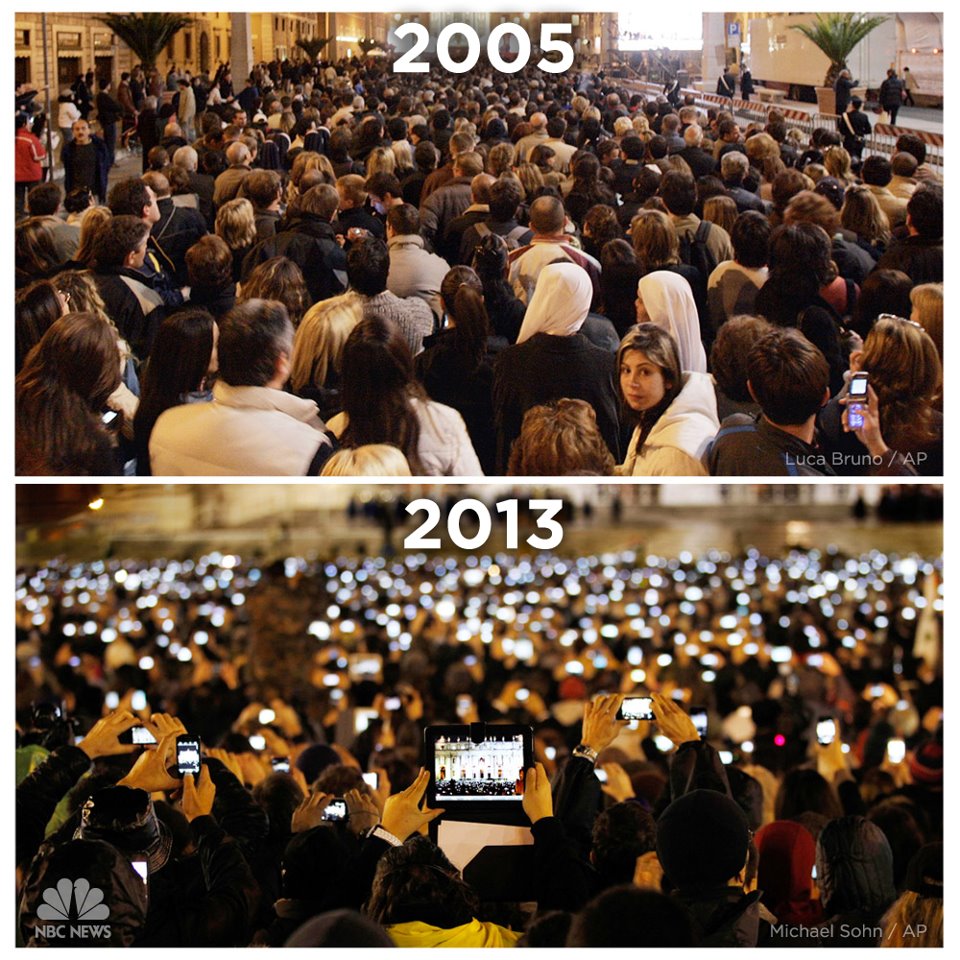
It’s no secret that web design trends have changed quite a lot in recent years. These days, there is a huge emphasis on website owners to embrace responsive design. In a nutshell, responsive web design is the term used to describe sites that can adapt to virtually any screen size, regardless of it being part of a desktop or mobile device.
The beauty of responsive web design is that the site automatically changes style according to the screen size and device type used. For instance, a responsive design will show larger fonts and a simpler design on mobile screens such as smartphones and tablets.
Responsive web design also offers a variety of other benefits too. Still not convinced? Here is why you need to take this seriously if you plan on developing a high-traffic site:
More people are surfing the Web from mobile devices

Outside St Peters Square for the Papal Conclave 2005 vs 2013
Once upon a time, the only “portable” way to go online while on the move was to fire up a notebook or its smaller cousin, the netbook. Today, we live in a digital age where the mobile phone we use often possess as much processing power as our home and office computers!
Today’s smartphones allow us the freedom to carry out a variety of tasks, such as running productivity apps like email clients. Plus, with faster mobile data speeds now commonplace, it’s easier than ever to get online while you’re out and about.
With the evolution of smartphone and tablet devices, we are seeing an increasing trend of people that favor those mobile devices over desktops and laptops for Web surfing. Courtesy of Statista, here are some insightful facts about our ever-growing use of smartphones and tablets today:
- 56% of all U.S. searches on Google originate from mobiles;¹
- 48.33% of all global Web traffic originates from smartphones and tablets;²
- 45% of all Internet users in the United States go online using a mobile device.³
As you can tell from the statistics above, mobile Internet usage is strong not just in America but across the planet. The advantage of using a smartphone or tablet to go online is that one can do so from virtually any location. Plus, the battery life in modern mobile devices means surfers can go online for hours, whereas a laptop may only last an hour or two before needing to charge again.
Google gives preference to mobile-friendly websites

It’s no secret that Google continually refines its search engine algorithms to provide the best possible user experience. Back in May 2016, the Internet giant confirmed an update4 to its algorithms that meant responsive websites would rank better than sites that only worked well on desktop screens.
Given that there is approximately one billion websites5 live on the Internet at any one time, competition is fierce on the World Wide Web. As a result, you will no doubt want your site to rank higher for relevant keyword searches than any competing sites.
From a search engine optimization perspective, it makes sense to ensure that your site’s design has a mobile-friendly responsive layout. It doesn’t matter whether you sell products and services on your website, or you just have a personal homepage. If you want more traffic to your site, you don’t have much choice but to admit that you need these increasing numbers of mobiles visitors to find you!
A responsive website is cost-effective

Back in the days where responsive web design wasn’t commonplace, site owners would have to develop two versions of their online homes; one for desktop, and one for mobile. As you can appreciate, such an approach meant that it often took a lot of time to keep sites updated and functioning well.
And if you paid a web designer to manage your content and design for you, that would usually mean you’d have to pay for two lots of updates! Thankfully, responsive web design offers a cost-effective solution as you only have one website to manage.
Aside from the cost savings, you will spend less time making any changes to your site, meaning that you can concentrate more on other important tasks in your day.
You will improve your user’s experience
Last, but not least, it is essential that your website targets your audience without any problems. If you have a non-responsive design on your site, mobile users would have to squint their eyes or “pinch” the screen to expand the font size of your pages!
Responsive web design removes those issues and offers a stable and functional way to display your content to mobile users. Mobile visitors will also be more likely to return to your site in the future.
1https://www.statista.com/topics/1710/search-engine-usage/
2https://www.statista.com/topics/779/mobile-internet/
3https://www.statista.com/statistics/682856/share-of-mobile-internet-traffic-countries-device/
4http://searchengineland.com/googles-mobile-friendly-algorithm-boost-rolled-249357
Recent Comments